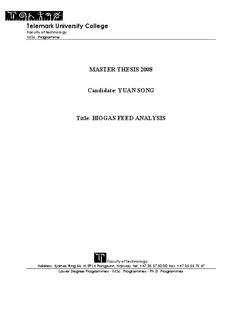| dc.description.abstract | Biogas production is regarded as the best energy recovery process from wet organic solid wastes (WOSW). Feed composition, storage conditions and time will influence the compositions of feed to biogas processes. In this study, apple juice from Meierienes Juice factory was used as the model substrates to mimic the liquid phase that can be extracted from fruit or juice industry WOSW. A series of batch experiments were carried out with different initial feed concentrations (0, 1, 2, 5, 10 %) of apple juice mixed with a biogas culture from the local anaerobic digester (AD). The initial feed content of 2 % and 5 % (weight %) gave the high biogas yields 55 (mL biogas per mL feed consumed), compared to 1 % and 10 %, which gave the biogas yields of 42 (mL biogas per mL feed consumed) perhaps due to substrate inhibition. The biogas yield data from 2 % and 5 % feed case were used for simulation in ADM1 to estimate the substrate compositions. Measured and estimation data from ADM1 are similar and show that the apple juice included mainly sugar, some protein, fat and organic acids with the total sCOD = 120 g COD/L. It implies that ADM1 can be used as a soft sensor method to estimate the substrate composition quite accurately from simple biogas measurements in batch experiments. Three different inoculum preparation methods were used in this study: Slurry from outlet of AD reactor (unfiltered); Leachate from sieve filtered (pore size: 500 μm); Leachate from belt filter process after AD reactor. The study show that the inoculum prepared from belt filter leachate was suitable for biogas production studies and had some advantages compared to unfiltered cultures. Micro-aeration treatment in the AD process was also tested in batch experiments. The results show that suitable amounts of air (oxygen) supply requires careful control for micro-aeration treatment to have a positive effect on biogas production in AD processes. An experiment of continuous flow bioreactor (CFB) for acidogenesis was also carried out to study the feed buffer capacity/pH effect on H2 yields and consumptions. The H2 production rate was 8 mmol/L /d at pH =7.3, and 4 mmol/L /d at pH =3.7. H2 was both produced and consumed in the reactor. pH also influenced the acid accumulation and therefore the metabolic pathways. Five main hypotheses were tested in this study leading to the following conclusions: (1) Apple juice can be used as a model substrate for the study of fermentation and biogas production; (2) Food to microorganism (F/M) ratios can be used to identify the substrate overload issues or the substrate inhibition problems; (3) Leachate from the belt filter process after the AD reactor can be used as the inoculum for the study of biogas production processes; (4) Biogas substrate composition can be estimated from simple batch tests and ADM1 simulations; (5) pH influences the metabolic pathway selection of glucose fermentation. | |
